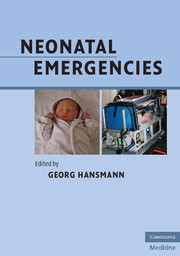Book contents
- Frontmatter
- Contents
- List of contributors
- Foreword (1)
- Foreword (2)
- Preface
- Acknowledgments
- Section 1 Organization of neonatal transport
- Section 2 Basics in cardiopulmonary resuscitation of newborn infants
- Basic equipment setup for initial neonatal care and resuscitation
- Drugs for neonatal emergencies
- Postnatal cardiopulmonary adaptation
- ABC Techniques and Procedures
- Sunctioning
- Stimulation, oxygen supplementation, bag-and-mask ventilation (M-PPV), pharyngeal/bi-nasal CPAP, and pharyngeal positive pressure ventilation
- Endotracheal intubation and gastric tube placement
- Laryngeal mask airway (LMA)
- Chest compressions
- Peripheral venous access
- Umbilical vein/artery catheterization (UVC, UAC)
- Central venous access (internal jugular vein)
- Intraosseous access
- Cord clamping
- Management of high-risk infants in the delivery room
- Monitoring in the delivery room and during neonatal transport
- Hygiene in the delivery room and during neonatal transport (infection control)
- When to call a pediatrician to the delivery room
- Checklist for the postnatal treatment of newborn infants
- Assigning individual duties in the delivery room
- Clinical assessment of the newborn infant
- Cardiopulmonary resuscitation of newborn infants at birth
- Volume therapy and sodium bicarbonate supplementation in preterm and term newborn infants
- Absolute and relative indications for neonatal transport and NICU admission
- Communication with mother and father
- Coordinating neonatal transport and patient sign-out to the NICU team
- Documentation and feedback after neonatal emergency transport
- Ethics in neonatal intensive care
- Perinatal images of preterm and term infants
- Mechanical ventilation of the neonate
- Questions for review (basics)
- References (Section 2)
- Section 3 Classic and rare scenarios in the neonatal period
- Section 4 Transport
- Section 5 Appendix
- Index
- Plate section
Endotracheal intubation and gastric tube placement
from Section 2 - Basics in cardiopulmonary resuscitation of newborn infants
Published online by Cambridge University Press: 05 March 2012
- Frontmatter
- Contents
- List of contributors
- Foreword (1)
- Foreword (2)
- Preface
- Acknowledgments
- Section 1 Organization of neonatal transport
- Section 2 Basics in cardiopulmonary resuscitation of newborn infants
- Basic equipment setup for initial neonatal care and resuscitation
- Drugs for neonatal emergencies
- Postnatal cardiopulmonary adaptation
- ABC Techniques and Procedures
- Sunctioning
- Stimulation, oxygen supplementation, bag-and-mask ventilation (M-PPV), pharyngeal/bi-nasal CPAP, and pharyngeal positive pressure ventilation
- Endotracheal intubation and gastric tube placement
- Laryngeal mask airway (LMA)
- Chest compressions
- Peripheral venous access
- Umbilical vein/artery catheterization (UVC, UAC)
- Central venous access (internal jugular vein)
- Intraosseous access
- Cord clamping
- Management of high-risk infants in the delivery room
- Monitoring in the delivery room and during neonatal transport
- Hygiene in the delivery room and during neonatal transport (infection control)
- When to call a pediatrician to the delivery room
- Checklist for the postnatal treatment of newborn infants
- Assigning individual duties in the delivery room
- Clinical assessment of the newborn infant
- Cardiopulmonary resuscitation of newborn infants at birth
- Volume therapy and sodium bicarbonate supplementation in preterm and term newborn infants
- Absolute and relative indications for neonatal transport and NICU admission
- Communication with mother and father
- Coordinating neonatal transport and patient sign-out to the NICU team
- Documentation and feedback after neonatal emergency transport
- Ethics in neonatal intensive care
- Perinatal images of preterm and term infants
- Mechanical ventilation of the neonate
- Questions for review (basics)
- References (Section 2)
- Section 3 Classic and rare scenarios in the neonatal period
- Section 4 Transport
- Section 5 Appendix
- Index
- Plate section
Summary
Both endotracheal intubation and gastric tube placement will be discussed here together, as intubation always requires gastric tube placement to enable gastric decompression (after bag-and-mask ventilation) and drainage of air and fluid. Gastric air removal consequently improves the excursion of the diaphragm. Moreover, esophageal atresia may be diagnosed clinically by this procedure, when the tube cannot be placed into the stomach, and instead rolls up in the oropharynx (if in doubt, inject 10 ml of air into the gastric tube and auscultate simultaneously over the gastric area).
Indication
See p. 158.
Urgency for intubation – decision making based on the clinical presentation of the neonate
Elective intubation
Semi-elective (“semi-urgent to urgent”) intubation
Emergency intubation
Elective and semi-elective intubation
Elective intubation
Clinical presentation: stable, spontaneously breathing neonate with adequate SpO2 and blood gas
For premedication see p. 83
Nasotracheal intubation is preferred by many centers because of the more secure ET fixation (lower accidental extubation rates); alternative: oral intubation
Indication: e.g., a spontaneously breathing neonate, receiving continuous prostaglandin E1 (PGE1) intravenous (IV) infusion prior to a long distant transport (e.g., TGA, HLH)
Semi-elective intubation
Clinical presentation: neonate with acceptable SpO2 and heart rate under bag-and-mask ventilation or NP-CPAP
For premedication see p. 83
Nasotracheal intubation or oral intubation
Indication: e.g., a neonate with poor lung expansion/respiratory distress syndrome with CO2 retention prior to respiratory failure
Information
- Type
- Chapter
- Information
- Neonatal Emergencies , pp. 82 - 95Publisher: Cambridge University PressPrint publication year: 2009
Accessibility standard: Unknown
Why this information is here
This section outlines the accessibility features of this content - including support for screen readers, full keyboard navigation and high-contrast display options. This may not be relevant for you.Accessibility Information
- 1
- Cited by
